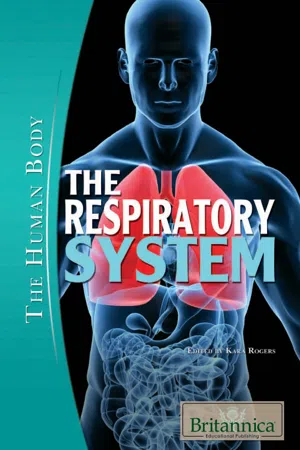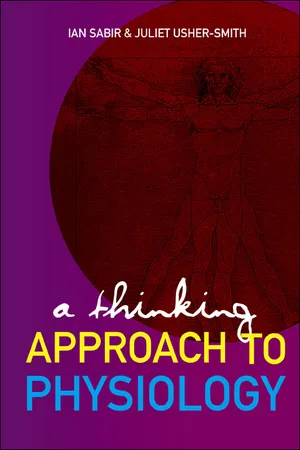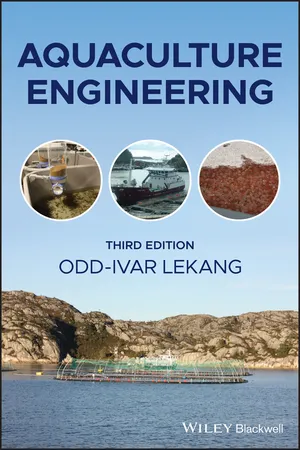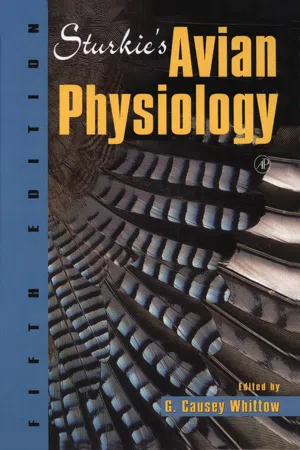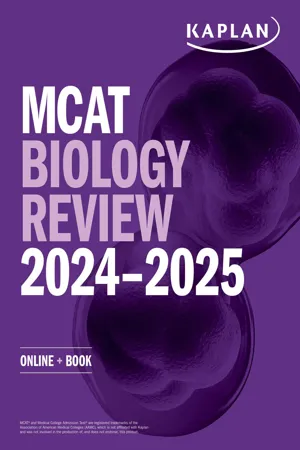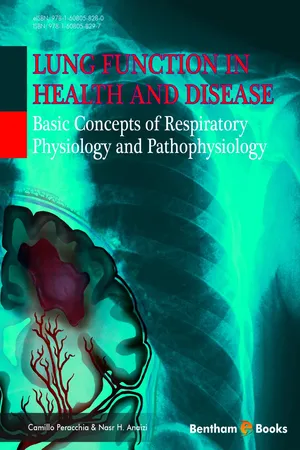Biological Sciences
Gas Exchange
Gas exchange is the process by which oxygen is taken in and carbon dioxide is released from an organism. In animals, this occurs in the respiratory system, where oxygen from the air is absorbed into the bloodstream and carbon dioxide is removed from the body. In plants, gas exchange involves the uptake of carbon dioxide and release of oxygen during photosynthesis.
Written by Perlego with AI-assistance
Related key terms
Related key terms
1 of 4
Related key terms
1 of 3
8 Key excerpts on "Gas Exchange"
- eBook - ePub
- Britannica Educational Publishing, Kara Rogers(Authors)
- 2010(Publication Date)
- Britannica Educational Publishing(Publisher)
AS EXCHANGE AND RESPIRATORY ADAPTATIONI nhaled air is rich in oxygen, which is needed to support the functions of the body’s various tissues. For inhaled oxygen to reach these tissues, however, it must first undergo a process of Gas Exchange that occurs at the level of the alveoli in the lungs. Blood vessels that pass alongside the alveoli membranes absorb the oxygen and, in exchange, transfer carbon dioxide to the alveoli. The oxygen is then distributed by the blood to the tissues, whereas the carbon dioxide is expelled from the alveoli during exhalation. At high altitudes or during activities such as deep-sea diving, the respiratory system, as well as other organ systems, adapt to variations in atmospheric pressure. This process of adaptation is necessary to maintain normal physiological function.Gas Exchange
Respiratory gases—oxygen and carbon dioxide—move between the air and the blood across the respiratory exchange surfaces in the lungs. The structure of the human lung provides an immense internal surface that facilitates Gas Exchange between the alveoli and the blood in the pulmonary capillaries. The area of the alveolar surface in the adult human is about 160 square metres (1,722 square feet). Gas Exchange across the membranous barrier between the alveoli and capillaries is enhanced by the thin nature of the membrane, about 0.5 micrometre, or 1/100 of the diameter of a human hair.Changes in the atmosphere’s pressure occur when deep-sea diving and require the respiratory system to adapt . Shutterstock.comRespiratory gases move between the environment and the respiring tissues by two principal mechanisms, convection and diffusion. Convection, or mass flow, is responsible for movement of air from the environment into the lungs and for movement of blood between the lungs and the tissues. Respiratory gases also move by diffusion across tissue barriers such as membranes. Diffusion is the primary mode of transport of gases between air and blood in the lungs and between blood and respiring tissues in the body. The process of diffusion is driven by the difference in partial pressures of a gas between two locales. In a mixture of gases, the partial pressure of each gas is directly proportional to its concentration. The partial pressure of a gas in fluid is a measure of its tendency to leave the fluid when exposed to a gas or fluid that does not contain that gas. A gas will diffuse from an area of greater partial pressure to an area of lower partial pressure regardless of the distribution of the partial pressures of other gases. There are large changes in the partial pressures of oxygen and carbon dioxide as these gases move between air and the respiring tissues. The partial pressure of carbon dioxide in this pathway is lower than the partial pressure of oxygen, caused by differing modes of transport in the blood, but almost equal quantities of the two gases are involved in metabolism and Gas Exchange. - eBook - ePub
- Suzanne Currie, David H. Evans, Suzanne Currie, David H. Evans(Authors)
- 2020(Publication Date)
- CRC Press(Publisher)
3 Gas Exchange Jodie L. Rummer and Colin J. Brauner CONTENTS 3.1 Introduction 3.2 From Environment to Gill Branchial Gas Transfer 3.2.1 Ventilation 3.2.2 Morphology 3.2.3 Diffusion across Membranes 3.2.4 The Osmorespiratory Compromise 3.3 Circulatory Transport of Respiratory Gases 3.3.1 Blood 3.3.1.1 Oxygen 3.3.1.2 Carbon Dioxide 3.3.2 Blood Flow and Perfusion 3.4 Diffusion at the Tissue Level 3.5 Conclusion Acknowledgements References3.1 Introduction
Oxygen is a prerequisite for life for all fish species with no known exceptions. Oxygen (O2 ) uptake from the environment, transport across respiratory surfaces and through the circulatory system, and ultimately, delivery to metabolizing tissue, with the reverse for carbon dioxide (CO2 ), which is produced in approximately equal amounts, have been topics of interest for fish physiologists for centuries. Yet, Gas Exchange is not just restricted to O2 and CO2 . Ammonia (NH3 ) excretion, also collectively part of Gas Exchange, is the key pathway for nitrogenous waste elimination for both marine and freshwater fishes. Therefore, Gas Exchange includes O2 , CO2 , and NH3 and, at least in most adult fishes, primarily occurs at the gills. The skin and air-breathing organs can also be used for Gas Exchange, depending on life stage and species, and will be discussed briefly here but elaborated upon in other chapters. As Gas Exchange in fishes has been reviewed relatively recently in detail (Evans et al., 2005; Randall et al., 2014; Harter and Brauner, 2017), only the fundamentals are reviewed here (focusing on O2 and CO2 ) along with more recent advances in the field. In this chapter, we focus on the role of the gill in Gas Exchange, reviewing aspects related to ventilation, morphology, contact with the external environment, diffusion across membranes, blood flow and perfusion, and diffusion at the tissue level (Figure 3.1 ). Cellular metabolism, the next logical step in this cascade, is discussed at both the cellular and the whole-organism level in Chapter 10 - eBook - ePub
- Ian N Sabir, Juliet A Usher-Smith(Authors)
- 2008(Publication Date)
- WSPC(Publisher)
CHAPTER 4 The Respiratory SystemAll living cells have an absolute requirement for a regular supply of energy. Energy is usually handled in the form of the molecule adenine triphosphate (ATP), a product of a series of metabolic reactions within the mitochondria of each cell together referred to as respiration. A fuel such as glucose is the only essential substrate for respiration. However, the efficiency of the process is increased by up to eight times in the presence of O2 , which ultimately takes the role of an oxidising agent. The provision of O2 to the mitochondria, and the removal of the waste product of respiration, CO2 , are therefore essential for life. This chapter considers how these two goals are achieved at the level of the whole organism.The process of delivering O2 to and removing CO2 from the body may be split into three: transporting the gases into and out of the organism, getting the substance to or from the active cells within the organism and finally getting the substance to or from the mitochondria within each cell. In organisms such as bacteria where surface area to volume ratio is large and distances within the organism are small, simple diffusion is sufficient to solve these problems. This same strategy is used to supply O2 to the human cornea. However, in larger multicellular organisms such as humans, distances are ordinarily limiting. We therefore require a dedicated organ, the lungs, to provide a large surface area over which Gas Exchange can occur. Furthermore, we also require a specialised circulatory system, the bloodsteam, to carry these gases around the body. We will begin by discussing the transport of gases into and out of the lungs, then focus on the exchange of gases between the lungs and the blood before finally considering how these gases are carried in the blood. The transport of this blood to the tissues is dealt with in Chapter 5 - eBook - ePub
- Roderick Nigel Finn, Roderick Nigel Finn(Authors)
- 2020(Publication Date)
- CRC Press(Publisher)
Part 2Respiration & Homeostasis
Passage contains an image
CHAPTER
4
Gas Exchange
Bernd Pelster1 , 2 , *Introduction
The form and function of animal respiratory and circulatory systems have attracted considerable attention for several hundred years. While the main organs of Gas Exchange (J O2 , J CO2 , J NH3 ) in adult fishes are the gills, they are also responsible for hydromineral and acid-base balance (Evans et al. 1999, 2005), nitrogenous waste excretion (Randall et al. 1999; Terjesen, this volume), hormone production (Zaccone et al. 1996, 2006), and activation or inactivation of circulating metabolites (Olson, 1998). Although the circulatory system is typically the first functioning organ during early embryonic development (Rombough, 1997; Pelster, 1999, 2002, Hall, this volume, Burggren & Bagatto, this volume), gills develop much later (Rombough, 2002, 2004). Gas Exchange, however, is required right from the start of development of the fertilised egg. This implies that Gas Exchange initially must occur through the cellular integument of the developing embryo, having traversed the boundary layer, chorion and perivitelline fluids (PVF ) of the embryo, or the surface epithelium of the hatched larva. The gills only supersede this function once they have developed. In addition, the autonomic nervous system, which controls cardiac activity and other organs, only becomes fully functional during later stages of development (Protas & Leontieva, 1992; Jacobsson & Fritsche, 1999; Schwerte et al ., 2006; Holmberg et al., - eBook - ePub
- Odd-Ivar Lekang(Author)
- 2019(Publication Date)
- Wiley-Blackwell(Publisher)
A great deal of literature on aquaculture is available, but the literature regarding wastewater treatment, environmental engineering and water chemistry is also a source of useful information. Gas Exchange is a general operation in process technology but here typically other gases are included. Removal of gases from liquids is called gas stripping or degassing. To use liquids to take up gases is called gas absorption, gas washing or gas scrubbing, and the equipment are typically called scrubbers.12.2 Gas Exchange in fish
All Gas Exchanges take place over the gills of the fish as water continuously flows either because the fish swims or because the fish opens and closes its mouth to push the water through the gills (this varies across species). The gills of the fish are “constructed” in a way ensuring extremely large surface against the surrounding water. It is on this surface where the Gas Exchange occurs. The gases involved in the Gas Exchange are mainly oxygen and carbon dioxide. Nitrogen is not an interesting part of the Gas Exchange, unless the its concentration reaches above 100% saturation. Oxygen is taken up from the water via diffusion through the gills and is transported by the blood and held by haemoglobin in the red blood cells. When oxygen reaches the target cell, it disconnects from the haemoglobin.6 The main use of oxygen within the cell is for energy production. When energy is produced, the by‐product will be CO2 , which the cells have to get rid of via diffusion but a number of chemical reactions will then occur. Since CO2 is a part of the carbonate system (see Chapter 5 ), and pH in the blood is 7.4–8.1, therefore the transport of CO2 will not be as a gas but mainly as the ion HCO3 − in the plasma and H+ connected to haemoglobin. When it arrives to the gills, a chloride shift will take place and HCO3 − will be exchanged with Cl− and dehydrate to CO2 that is transferred to the water with diffusion over the gills.6Too high levels of gases in the water are toxic for the fish. This includes the major gases N2 and O2 as well as CO2 , NH3 and H2 - eBook - ePub
- G. Causey Whittow(Author)
- 1999(Publication Date)
- Academic Press(Publisher)
CHAPTER 10 RespirationF.L. POWELL Division of Physiology, Department of Medicine, School of Medicine, University of California, San Diego, La Jolla, California 92093-0623I. OverviewA. Oxygen CascadeB. Symbols and UnitsII. Anatomy of the Avian Respiratory SystemA. Upper AirwaysB. LungsC. Air SacsD. Respiratory System VolumesIII. Ventilation and Respiratory MechanicsA. Respiratory MusclesB. Mechanical PropertiesC. Ventilatory Flow PatternsIV. Pulmonary CirculationA. Anatomy of the Pulmonary CirculationB. Pulmonary Capillary VolumeC. Pulmonary Vascular Resistance and the Distribution of Blood FlowD. Fluid BalanceV. Gas Transport by BloodA. OxygenB. Carbon DioxideC. Acid-BaseD. Blood Gas MeasurementsVI. Pulmonary Gas ExchangeA. Basic Principles of Oxygen TransportB. Cross-Current Gas ExchangeC. Lung Diffusing CapacityD. Heterogeneity in the LungE. Frontiers: Gas Exchange during High-Altitude FlightF.Summary of O2 and CO2 Exchange in Avian LungsVII. Tissue Gas ExchangeA. MicrocirculationB. MyoglobinC. Effects of Hypoxia and ExerciseVIII. Control of BreathingA. Respiratory Rhythm GenerationB. Sensory InputsC. Ventilatory ReflexesReferencesI OVERVIEW
The primary function of the respiratory system in air-breathing vertebrates is Gas Exchange—delivering oxygen from the environment to the tissues and removing carbon dioxide from the tissues. The respiratory system is also critical for thermoregulation (by evaporative water loss) in birds and nonrespiratory functions such as vocalization, but these are not covered in this chapter. Generally, the respiratory system acts as a servant to the rest of the organism by delivering enough oxygen and removing sufficient carbon dioxide for metabolic demands. As oxygen demand increases, a variety of respiratory responses insure an adequate supply of oxygen. This involves the lung, respiratory mechanics, the pulmonary circulation, transport of oxygen and carbon dioxide in blood, pulmonary and tissue Gas Exchange, and the coordination of all these mechanisms by the respiratory control system. - No longer available |Learn more
MCAT Biology Review 2024-2025
Online + Book
- (Author)
- 2023(Publication Date)
- Kaplan Test Prep(Publisher)
Figure 6.5 . Because the gradient between the blood and air in the lungs is already present as the blood enters the lungs, no energy is required for gas transfer.Figure 6.5. Gas Exchange in the AlveolusKEY CONCEPT
O2 in the alveoli flows down its partial pressure gradient from the alveoli into the pulmonary capillaries, where it can bind to hemoglobin for transport. Meanwhile, CO2 flows down its partial pressure gradient from the capillaries into the alveoli for expiration.How would our respiratory systems adjust if we moved to higher altitudes where less oxygen is available? First, we would breathe more rapidly to try to avoid hypoxia; second, the binding dynamics of hemoglobin to oxygen would be altered to facilitate the unloading of oxygen at the tissues. As we will discuss in Chapter 7 of MCAT Biology Review, the natural response of hemoglobin to the decreased carbon dioxide concentration in the environment would actually be to decrease the unloading of oxygen to tissues, so other mechanisms must counteract and override this phenomenon. In the short term, the body can make more red blood cells to ensure the adequate delivery of oxygen. In the long term, the body could develop more blood vessels (vascularization), which would facilitate the distribution of oxygen to tissues.Thermoregulation
In order to maximize Gas Exchange, there is a tremendous surface area over which the alveoli and capillaries interact. Because the entire respiratory tract is highly vascular, it can also be used for thermoregulation, or the regulation of body temperature. Heat—the transfer of thermal energy—is regulated via the body surfaces by vasodilation and vasoconstriction. As capillaries expand, more blood can pass through these vessels, and a larger amount of thermal energy can be dissipated. As capillaries contract, less blood can pass through them, conserving thermal energy. Nasal and tracheal capillaries are most frequently used for these purposes within the respiratory system. While these capillary beds provide a mechanism for thermoregulation, humans predominantly regulate temperature using capillaries and sweat glands in the skin, or rapid muscle contraction (shivering). The respiratory system can also transfer heat to the environment through evaporation of water in mucous secretions. Other animals, such as dogs, take advantage of this cooling mechanism by panting - eBook - ePub
- Camillo Peracchia, Nasr H. Anaizi(Authors)
- 0(Publication Date)
- Bentham Science Publishers(Publisher)
Gas Exchange Camillo PeracchiaAbstract
This chapter focuses on the mechanisms of Gas Exchange between lungs and environment. In particular, it describes the changes in gas composition and physical property that take place as gases are flown in and out of the lungs. It explains the meaning of anatomical (conductive) dead space and describes methods for quantifying dead space, alveolar ventilation, oxygen consumption and carbon dioxide production. It introduces concepts of ideal versus average alveolar ventilation, alveolar dead space ventilation, right-to-left blood shunt (venous admixture), and body gas stores. It begins to explain how the complex relationship between alveolar ventilation and blood perfusion can be simplified into a “three compartment model” of the real lung. Finally, the relationship among alveolar ventilation, arterial PCO2 and metabolic rate is discussed and presented quantitatively.Keywords:: Alveolar Dead-Space, Alveolar Gas-Equation, Alveolar-Ideal Gas, Ambient-Temperature-Pressure-Saturated (ATPS), Blood Shunt, Body Gas-Stores, Body-Temperature-Pressure-Saturated (BTPS), Carbon-Dioxide Production, Conductive Dead-Space, Exchange Ratio (R), Expiration, Gas Composition, Inspiration, O2 -CO2 Diagram, Oxygen Consumption, Physiological Dead-Space, Respiratory Quotient (RQ), Standard-Temperature-Pressure-Dry (STPD), Steady-State Condition, Ventilation-PCO2 -Metabolism.SYMBOLS, ACRONYMS AND NORMAL VALUES: See Appendix 3
Let's Take a Breath – Inspiration
Every time we take a breath a volume of ambient air enters the lungs flowing through a tree-like arrangement of airways (nose, larynx, trachea and bronchi), known as conductive (or anatomical) dead space (VCd), a region in which there is virtually no Gas Exchange with blood. Inspired air eventually reaches the alveolar space, the region where Gas Exchange with blood takes place. As mentioned in Chapter 3, the volume of air that enters the lungs at each breath is called tidal volume (VT). The alveoli receive only a portion of the inspired air because the first volume of gas that enters the alveoli is alveolar gas that has remained in VCd at the end of expiration (FRC), and some of the inspired air remains in VCd at the end of inspiration (FRC + VT; Figs. 1 and 2 ). With normal breathing, approximately two thirds of VT reaches the alveolar space, while one third remains in VCd (Fig. 2
Index pages curate the most relevant extracts from our library of academic textbooks. They’ve been created using an in-house natural language model (NLM), each adding context and meaning to key research topics.
Explore more topic indexes
Explore more topic indexes
1 of 6
Explore more topic indexes
1 of 4
